Pros and Cons of a Human Rights Bill/Act/Charter for Australia
VerifiedAdded on 2023/06/10
|9
|2242
|149
Essay
AI Summary
This essay provides a critical analysis of the arguments for and against the implementation of a human rights bill, act, or charter in Australia. It begins by setting the scene, defining human rights, and explaining the historical context of human rights implementation, including the role of the United Nations. The essay then delves into the current state of human rights protection in Australia, highlighting the absence of a comprehensive bill of rights and examining existing constitutional and international mechanisms. Alternative legislative options for Australia are explored, drawing from both national and international examples such as the South African Bill of Rights, the United Kingdom Human Rights Act, the United Nations Declaration of Indigenous People, and The Victorian Charter of Rights. Each option is evaluated based on its potential advantages and disadvantages, with specific examples used to illustrate their impact. The essay concludes by summarizing the key arguments and recommending a deliberative approach to enacting a bill of rights, emphasizing the need to address inconsistencies in the current legal system and ensure justice for all Australians. Desklib provides access to this essay and many other resources to help students with their studies.
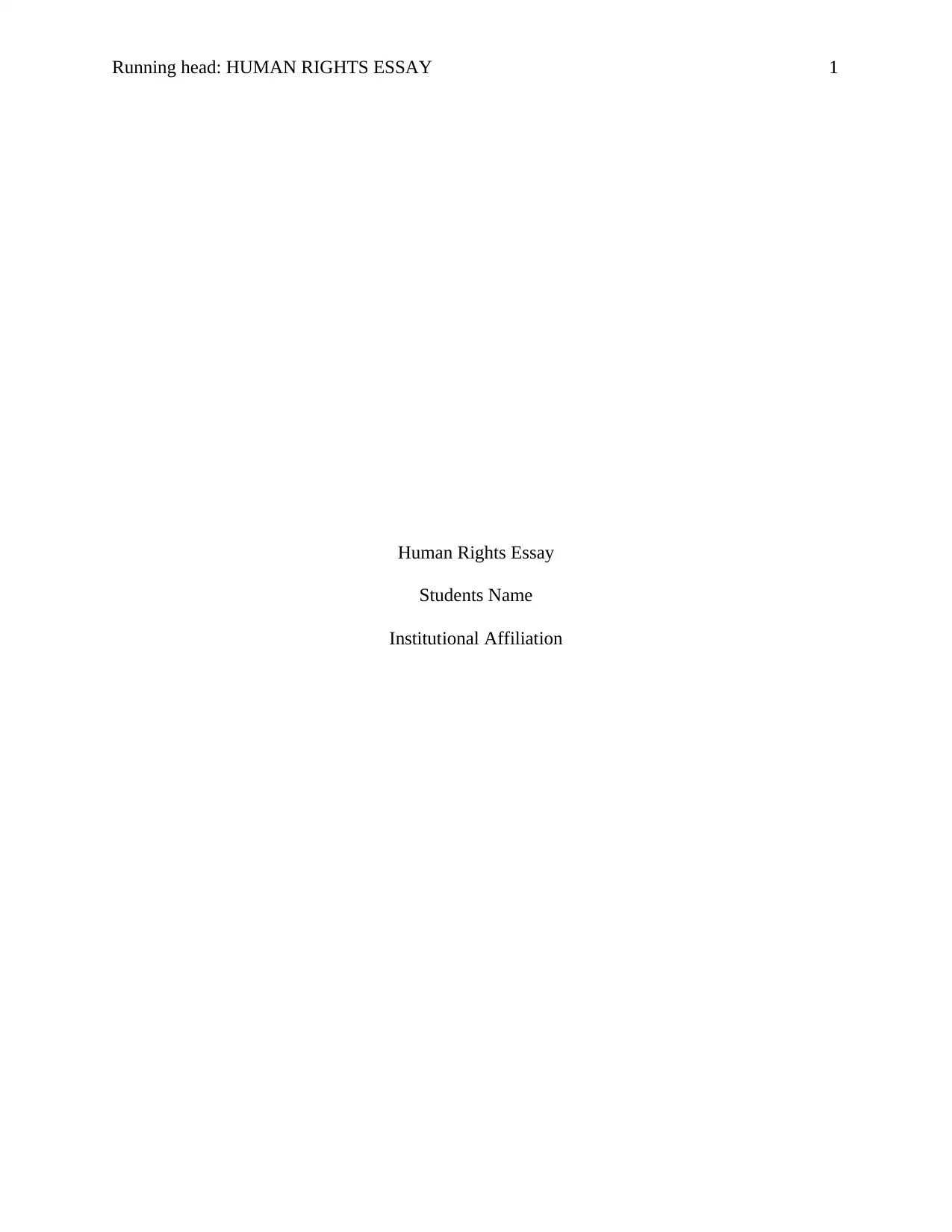
Running head: HUMAN RIGHTS ESSAY 1
Human Rights Essay
Students Name
Institutional Affiliation
Human Rights Essay
Students Name
Institutional Affiliation
Paraphrase This Document
Need a fresh take? Get an instant paraphrase of this document with our AI Paraphraser

HUMAN RIGHTS ESSAY 2
Human Rights Essay
Introduction
Setting the Scene
There is a widespread perception that Australia has a candid bill of rights. In the words of
Dixon (2016), Australia is the only country possessing primary democratic constitution on the
globe with justiciable human rights. The framers of the law found that the state saw no need for
the charter of human rights because there was a robust British Commonwealth tradition of the
protection of human rights and they feared that racial factory and mining laws could fragment
the support of the constitution (Commonwealth of Australia, 2009). The debate surrounding the
issue has some critics argue that the bill of rights in the country is narrow and in democracy and
comparative terms.
Background
Human rights are fundamental to all. Zifcak and King (2013) reiterate the Universal
Declaration of Human Rights that all people are born with dignity, have freedom, and rights
endowing them with reason and conscience to act towards one another with the spirit of
goodwill. The trajectory of human rights traces back to the prehistoric period where human
beings realised that they ought to consider one another with dignity (Ife, 2012). Throughout the
historical era, many organs and activism principles have laid the foundation for the future of
human rights protection. However, the 21st century presents the most comprehensive period
when stronger organs arose to safeguard the rights of all such as the United Nations (UN)
(Baylis, Smith & Owens, 2017). Formed after the WWII, the UN followed the collapse of the
League of Nations, and it owed the members the mandate to ensure continued tranquility.
Therefore, the United Nations Human Rights Charter was introduced as a measure to guarantee
Human Rights Essay
Introduction
Setting the Scene
There is a widespread perception that Australia has a candid bill of rights. In the words of
Dixon (2016), Australia is the only country possessing primary democratic constitution on the
globe with justiciable human rights. The framers of the law found that the state saw no need for
the charter of human rights because there was a robust British Commonwealth tradition of the
protection of human rights and they feared that racial factory and mining laws could fragment
the support of the constitution (Commonwealth of Australia, 2009). The debate surrounding the
issue has some critics argue that the bill of rights in the country is narrow and in democracy and
comparative terms.
Background
Human rights are fundamental to all. Zifcak and King (2013) reiterate the Universal
Declaration of Human Rights that all people are born with dignity, have freedom, and rights
endowing them with reason and conscience to act towards one another with the spirit of
goodwill. The trajectory of human rights traces back to the prehistoric period where human
beings realised that they ought to consider one another with dignity (Ife, 2012). Throughout the
historical era, many organs and activism principles have laid the foundation for the future of
human rights protection. However, the 21st century presents the most comprehensive period
when stronger organs arose to safeguard the rights of all such as the United Nations (UN)
(Baylis, Smith & Owens, 2017). Formed after the WWII, the UN followed the collapse of the
League of Nations, and it owed the members the mandate to ensure continued tranquility.
Therefore, the United Nations Human Rights Charter was introduced as a measure to guarantee

HUMAN RIGHTS ESSAY 3
that the freedom and rights of all people would prevail at all times. Australia has made
significant steps in the implementation of human rights but the 2006 Charter of Humans Rights
and Responsibilities Act famously known as The Victorian Charter of Rights was the landmark
political and constitutional history in the country (Dixon, 2016). The Victorian letter of rights
based its premises on the 1998 the United Kingdom Human Rights Act and the 1990 New
Zealand Bill of Rights Act. The enactment of the law lay in the idea that Australia had a good
history of human rights protection making her require enhancement through improved protection
for these rights.
The Motivation behind Human Rights Consultations
Notably, Australia is the only democratic country in the world without a bill of rights.
According to Dizon (2016), a comprehensive framework for the protection of human rights is the
critical check of democratic governance in the contemporary political world. Therefore,
Australia requires enacting laws and reforms in their country to align with other nations in the
area of safeguarding the rights and freedom of their citizens. The propounded legal framework
will ensure that the nation stands firm on the law to guarantee every citizen their rights without
favouritism or double standards because of proper legislative frameworks to address the
situation. For instance, the forced removal of the children of aborigines from their families and
their detention raised the question of the preparedness of the country to resolve human rights
crisis in the nation (Harris, 2017). Australia remains behind in enacting a human rights bill and it
applies some traditionally founded mechanisms to deal with issues surrounding infringement of
people’s rights that have negative and positive implications requiring the enactment of human
rights charter in the country.
Body
that the freedom and rights of all people would prevail at all times. Australia has made
significant steps in the implementation of human rights but the 2006 Charter of Humans Rights
and Responsibilities Act famously known as The Victorian Charter of Rights was the landmark
political and constitutional history in the country (Dixon, 2016). The Victorian letter of rights
based its premises on the 1998 the United Kingdom Human Rights Act and the 1990 New
Zealand Bill of Rights Act. The enactment of the law lay in the idea that Australia had a good
history of human rights protection making her require enhancement through improved protection
for these rights.
The Motivation behind Human Rights Consultations
Notably, Australia is the only democratic country in the world without a bill of rights.
According to Dizon (2016), a comprehensive framework for the protection of human rights is the
critical check of democratic governance in the contemporary political world. Therefore,
Australia requires enacting laws and reforms in their country to align with other nations in the
area of safeguarding the rights and freedom of their citizens. The propounded legal framework
will ensure that the nation stands firm on the law to guarantee every citizen their rights without
favouritism or double standards because of proper legislative frameworks to address the
situation. For instance, the forced removal of the children of aborigines from their families and
their detention raised the question of the preparedness of the country to resolve human rights
crisis in the nation (Harris, 2017). Australia remains behind in enacting a human rights bill and it
applies some traditionally founded mechanisms to deal with issues surrounding infringement of
people’s rights that have negative and positive implications requiring the enactment of human
rights charter in the country.
Body
⊘ This is a preview!⊘
Do you want full access?
Subscribe today to unlock all pages.

Trusted by 1+ million students worldwide

HUMAN RIGHTS ESSAY 4
The Current Situation in Human Rights Protection in Australia
Australia has no bill of rights to lay the foundation for resolving human right disputes. In
the words of Dixon (2016), Australia lacks a constitutional law of rights or a charter for
individual’s freedom. The Australian attorney-general George Brandis in 2014 agreed that unlike
the United States, the country does not have a platform enshrined in the constitution where they
can articulate the rights and freedom of their citizens (Dixon, 2016). However, the absence of a
bill of rights does not imply that the country does not have a foundation for the observance of
people freedom. Indeed, there are a set of entrenched constitutional rights commonly known as
the partial bill of rights (Commonwealth of Australia, 2009). For instance, the Section 80, 116,
117, and 51 (xxxi) of the constitution provides for the application of Commonwealth human
rights provisions on determining issues related to the infringement of the same. These four
sections of the law place the parliament at a focal point regarding the observance of the human
rights in the country as the house has the power to enact legislation in line with the
Commonwealth standards. Furthermore, the nation places significance on the international
bodies such as the UN acts on human rights while determining contentious issues of individual
rights. The country obliges to consider the rights of its people as per the provision of the global
agencies. For instance, the high court in the nation in the case of the ministry of immigration and
ethnic affairs granted Australia obligation under the treaty of the UN on the children rights
(Human Rights Law Centre, 2017). The situation in the country regarding human rights places
her at the forefront of the observance of human rights.
Alternative Legislative Options for Australia
The argument in favour of a bill of rights in Australia continues to gather momentum as
days pass. The contemplation for a bill of rights in the country should increase the pace to
The Current Situation in Human Rights Protection in Australia
Australia has no bill of rights to lay the foundation for resolving human right disputes. In
the words of Dixon (2016), Australia lacks a constitutional law of rights or a charter for
individual’s freedom. The Australian attorney-general George Brandis in 2014 agreed that unlike
the United States, the country does not have a platform enshrined in the constitution where they
can articulate the rights and freedom of their citizens (Dixon, 2016). However, the absence of a
bill of rights does not imply that the country does not have a foundation for the observance of
people freedom. Indeed, there are a set of entrenched constitutional rights commonly known as
the partial bill of rights (Commonwealth of Australia, 2009). For instance, the Section 80, 116,
117, and 51 (xxxi) of the constitution provides for the application of Commonwealth human
rights provisions on determining issues related to the infringement of the same. These four
sections of the law place the parliament at a focal point regarding the observance of the human
rights in the country as the house has the power to enact legislation in line with the
Commonwealth standards. Furthermore, the nation places significance on the international
bodies such as the UN acts on human rights while determining contentious issues of individual
rights. The country obliges to consider the rights of its people as per the provision of the global
agencies. For instance, the high court in the nation in the case of the ministry of immigration and
ethnic affairs granted Australia obligation under the treaty of the UN on the children rights
(Human Rights Law Centre, 2017). The situation in the country regarding human rights places
her at the forefront of the observance of human rights.
Alternative Legislative Options for Australia
The argument in favour of a bill of rights in Australia continues to gather momentum as
days pass. The contemplation for a bill of rights in the country should increase the pace to
Paraphrase This Document
Need a fresh take? Get an instant paraphrase of this document with our AI Paraphraser
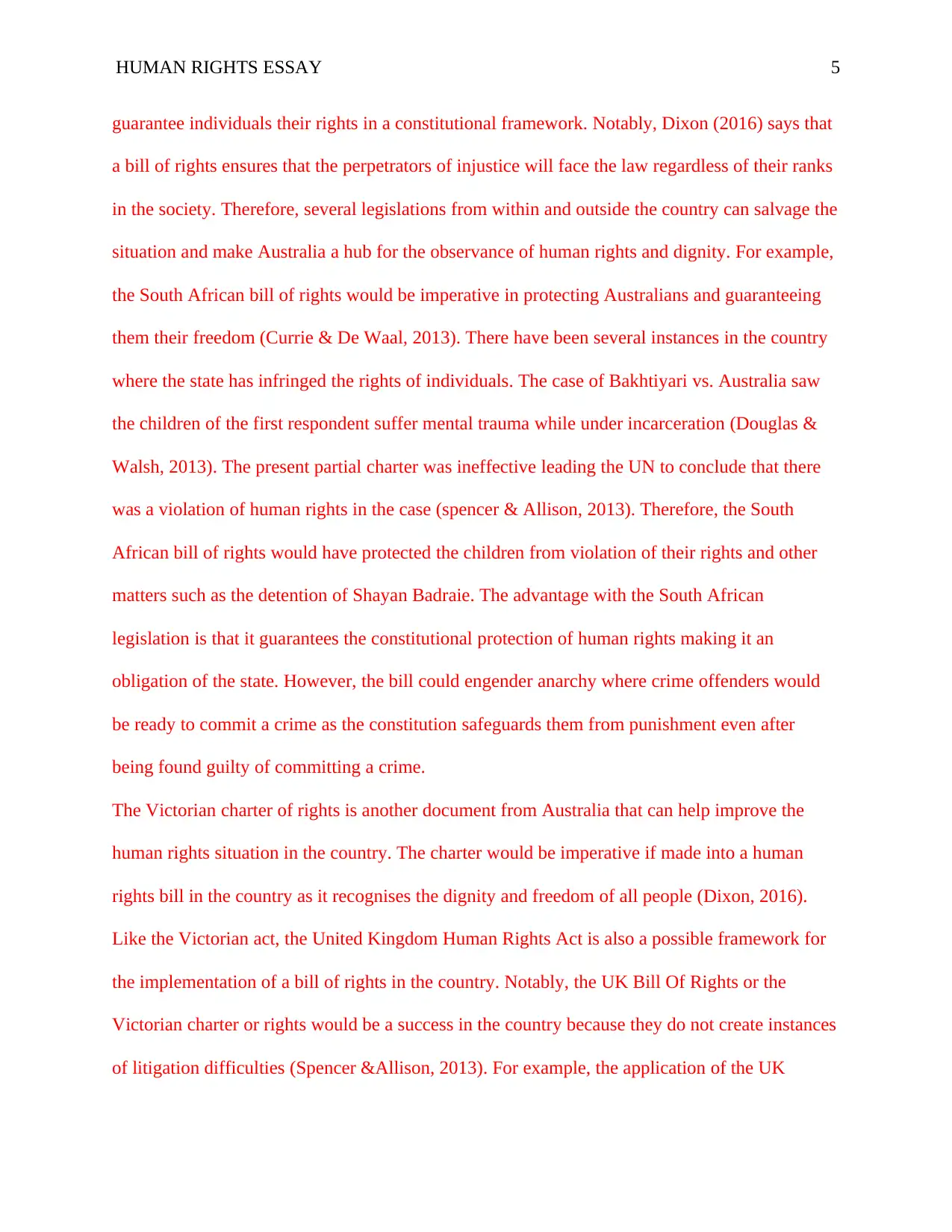
HUMAN RIGHTS ESSAY 5
guarantee individuals their rights in a constitutional framework. Notably, Dixon (2016) says that
a bill of rights ensures that the perpetrators of injustice will face the law regardless of their ranks
in the society. Therefore, several legislations from within and outside the country can salvage the
situation and make Australia a hub for the observance of human rights and dignity. For example,
the South African bill of rights would be imperative in protecting Australians and guaranteeing
them their freedom (Currie & De Waal, 2013). There have been several instances in the country
where the state has infringed the rights of individuals. The case of Bakhtiyari vs. Australia saw
the children of the first respondent suffer mental trauma while under incarceration (Douglas &
Walsh, 2013). The present partial charter was ineffective leading the UN to conclude that there
was a violation of human rights in the case (spencer & Allison, 2013). Therefore, the South
African bill of rights would have protected the children from violation of their rights and other
matters such as the detention of Shayan Badraie. The advantage with the South African
legislation is that it guarantees the constitutional protection of human rights making it an
obligation of the state. However, the bill could engender anarchy where crime offenders would
be ready to commit a crime as the constitution safeguards them from punishment even after
being found guilty of committing a crime.
The Victorian charter of rights is another document from Australia that can help improve the
human rights situation in the country. The charter would be imperative if made into a human
rights bill in the country as it recognises the dignity and freedom of all people (Dixon, 2016).
Like the Victorian act, the United Kingdom Human Rights Act is also a possible framework for
the implementation of a bill of rights in the country. Notably, the UK Bill Of Rights or the
Victorian charter or rights would be a success in the country because they do not create instances
of litigation difficulties (Spencer &Allison, 2013). For example, the application of the UK
guarantee individuals their rights in a constitutional framework. Notably, Dixon (2016) says that
a bill of rights ensures that the perpetrators of injustice will face the law regardless of their ranks
in the society. Therefore, several legislations from within and outside the country can salvage the
situation and make Australia a hub for the observance of human rights and dignity. For example,
the South African bill of rights would be imperative in protecting Australians and guaranteeing
them their freedom (Currie & De Waal, 2013). There have been several instances in the country
where the state has infringed the rights of individuals. The case of Bakhtiyari vs. Australia saw
the children of the first respondent suffer mental trauma while under incarceration (Douglas &
Walsh, 2013). The present partial charter was ineffective leading the UN to conclude that there
was a violation of human rights in the case (spencer & Allison, 2013). Therefore, the South
African bill of rights would have protected the children from violation of their rights and other
matters such as the detention of Shayan Badraie. The advantage with the South African
legislation is that it guarantees the constitutional protection of human rights making it an
obligation of the state. However, the bill could engender anarchy where crime offenders would
be ready to commit a crime as the constitution safeguards them from punishment even after
being found guilty of committing a crime.
The Victorian charter of rights is another document from Australia that can help improve the
human rights situation in the country. The charter would be imperative if made into a human
rights bill in the country as it recognises the dignity and freedom of all people (Dixon, 2016).
Like the Victorian act, the United Kingdom Human Rights Act is also a possible framework for
the implementation of a bill of rights in the country. Notably, the UK Bill Of Rights or the
Victorian charter or rights would be a success in the country because they do not create instances
of litigation difficulties (Spencer &Allison, 2013). For example, the application of the UK
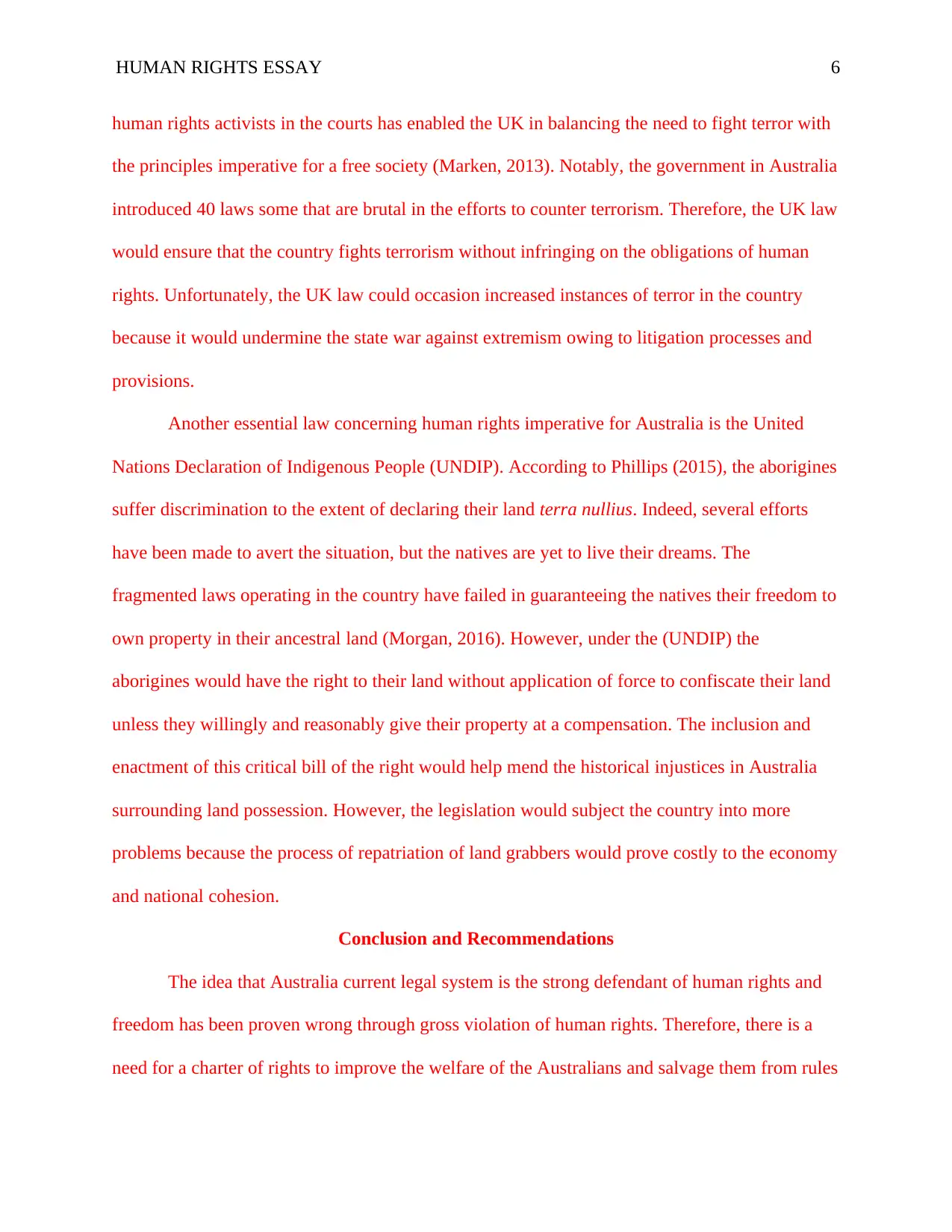
HUMAN RIGHTS ESSAY 6
human rights activists in the courts has enabled the UK in balancing the need to fight terror with
the principles imperative for a free society (Marken, 2013). Notably, the government in Australia
introduced 40 laws some that are brutal in the efforts to counter terrorism. Therefore, the UK law
would ensure that the country fights terrorism without infringing on the obligations of human
rights. Unfortunately, the UK law could occasion increased instances of terror in the country
because it would undermine the state war against extremism owing to litigation processes and
provisions.
Another essential law concerning human rights imperative for Australia is the United
Nations Declaration of Indigenous People (UNDIP). According to Phillips (2015), the aborigines
suffer discrimination to the extent of declaring their land terra nullius. Indeed, several efforts
have been made to avert the situation, but the natives are yet to live their dreams. The
fragmented laws operating in the country have failed in guaranteeing the natives their freedom to
own property in their ancestral land (Morgan, 2016). However, under the (UNDIP) the
aborigines would have the right to their land without application of force to confiscate their land
unless they willingly and reasonably give their property at a compensation. The inclusion and
enactment of this critical bill of the right would help mend the historical injustices in Australia
surrounding land possession. However, the legislation would subject the country into more
problems because the process of repatriation of land grabbers would prove costly to the economy
and national cohesion.
Conclusion and Recommendations
The idea that Australia current legal system is the strong defendant of human rights and
freedom has been proven wrong through gross violation of human rights. Therefore, there is a
need for a charter of rights to improve the welfare of the Australians and salvage them from rules
human rights activists in the courts has enabled the UK in balancing the need to fight terror with
the principles imperative for a free society (Marken, 2013). Notably, the government in Australia
introduced 40 laws some that are brutal in the efforts to counter terrorism. Therefore, the UK law
would ensure that the country fights terrorism without infringing on the obligations of human
rights. Unfortunately, the UK law could occasion increased instances of terror in the country
because it would undermine the state war against extremism owing to litigation processes and
provisions.
Another essential law concerning human rights imperative for Australia is the United
Nations Declaration of Indigenous People (UNDIP). According to Phillips (2015), the aborigines
suffer discrimination to the extent of declaring their land terra nullius. Indeed, several efforts
have been made to avert the situation, but the natives are yet to live their dreams. The
fragmented laws operating in the country have failed in guaranteeing the natives their freedom to
own property in their ancestral land (Morgan, 2016). However, under the (UNDIP) the
aborigines would have the right to their land without application of force to confiscate their land
unless they willingly and reasonably give their property at a compensation. The inclusion and
enactment of this critical bill of the right would help mend the historical injustices in Australia
surrounding land possession. However, the legislation would subject the country into more
problems because the process of repatriation of land grabbers would prove costly to the economy
and national cohesion.
Conclusion and Recommendations
The idea that Australia current legal system is the strong defendant of human rights and
freedom has been proven wrong through gross violation of human rights. Therefore, there is a
need for a charter of rights to improve the welfare of the Australians and salvage them from rules
⊘ This is a preview!⊘
Do you want full access?
Subscribe today to unlock all pages.

Trusted by 1+ million students worldwide
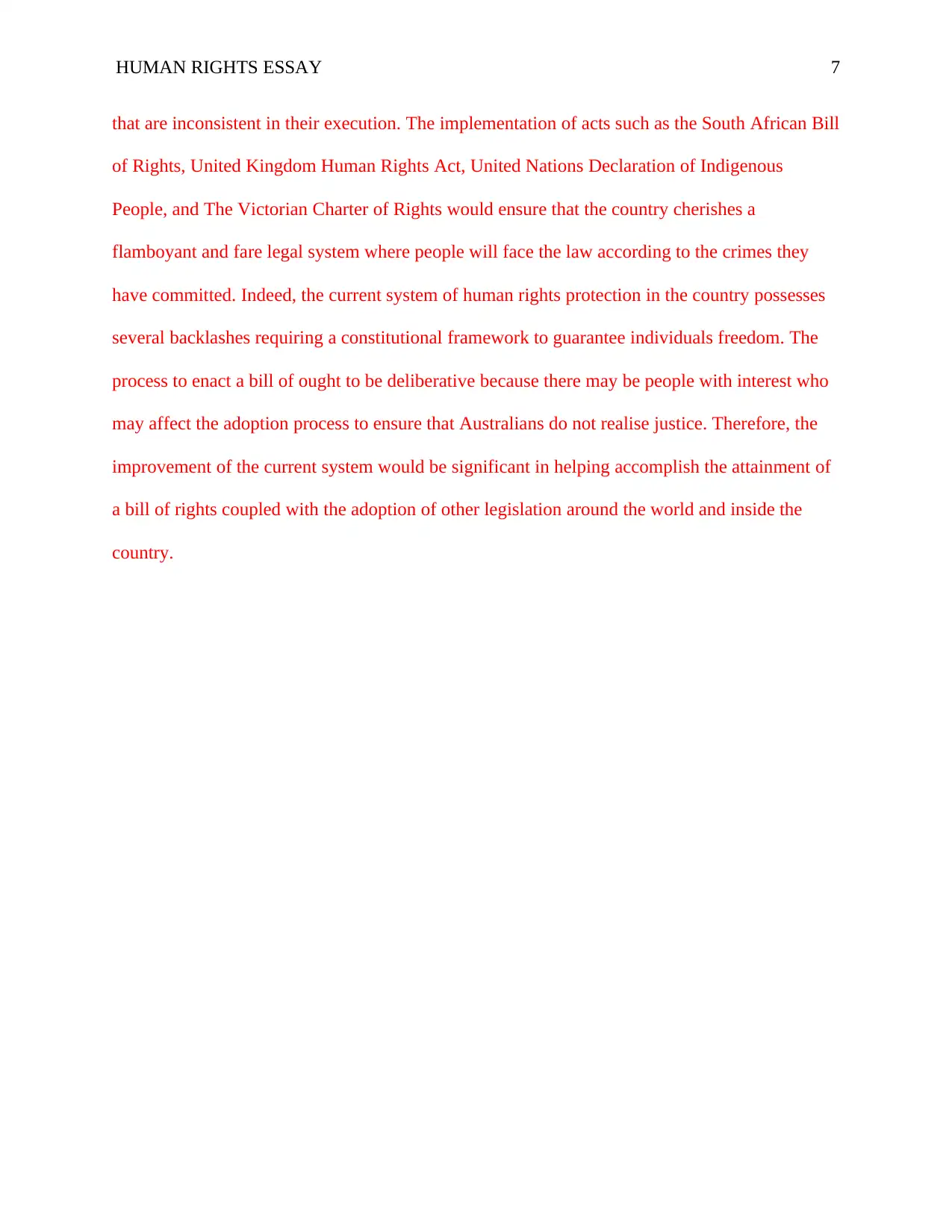
HUMAN RIGHTS ESSAY 7
that are inconsistent in their execution. The implementation of acts such as the South African Bill
of Rights, United Kingdom Human Rights Act, United Nations Declaration of Indigenous
People, and The Victorian Charter of Rights would ensure that the country cherishes a
flamboyant and fare legal system where people will face the law according to the crimes they
have committed. Indeed, the current system of human rights protection in the country possesses
several backlashes requiring a constitutional framework to guarantee individuals freedom. The
process to enact a bill of ought to be deliberative because there may be people with interest who
may affect the adoption process to ensure that Australians do not realise justice. Therefore, the
improvement of the current system would be significant in helping accomplish the attainment of
a bill of rights coupled with the adoption of other legislation around the world and inside the
country.
that are inconsistent in their execution. The implementation of acts such as the South African Bill
of Rights, United Kingdom Human Rights Act, United Nations Declaration of Indigenous
People, and The Victorian Charter of Rights would ensure that the country cherishes a
flamboyant and fare legal system where people will face the law according to the crimes they
have committed. Indeed, the current system of human rights protection in the country possesses
several backlashes requiring a constitutional framework to guarantee individuals freedom. The
process to enact a bill of ought to be deliberative because there may be people with interest who
may affect the adoption process to ensure that Australians do not realise justice. Therefore, the
improvement of the current system would be significant in helping accomplish the attainment of
a bill of rights coupled with the adoption of other legislation around the world and inside the
country.
Paraphrase This Document
Need a fresh take? Get an instant paraphrase of this document with our AI Paraphraser
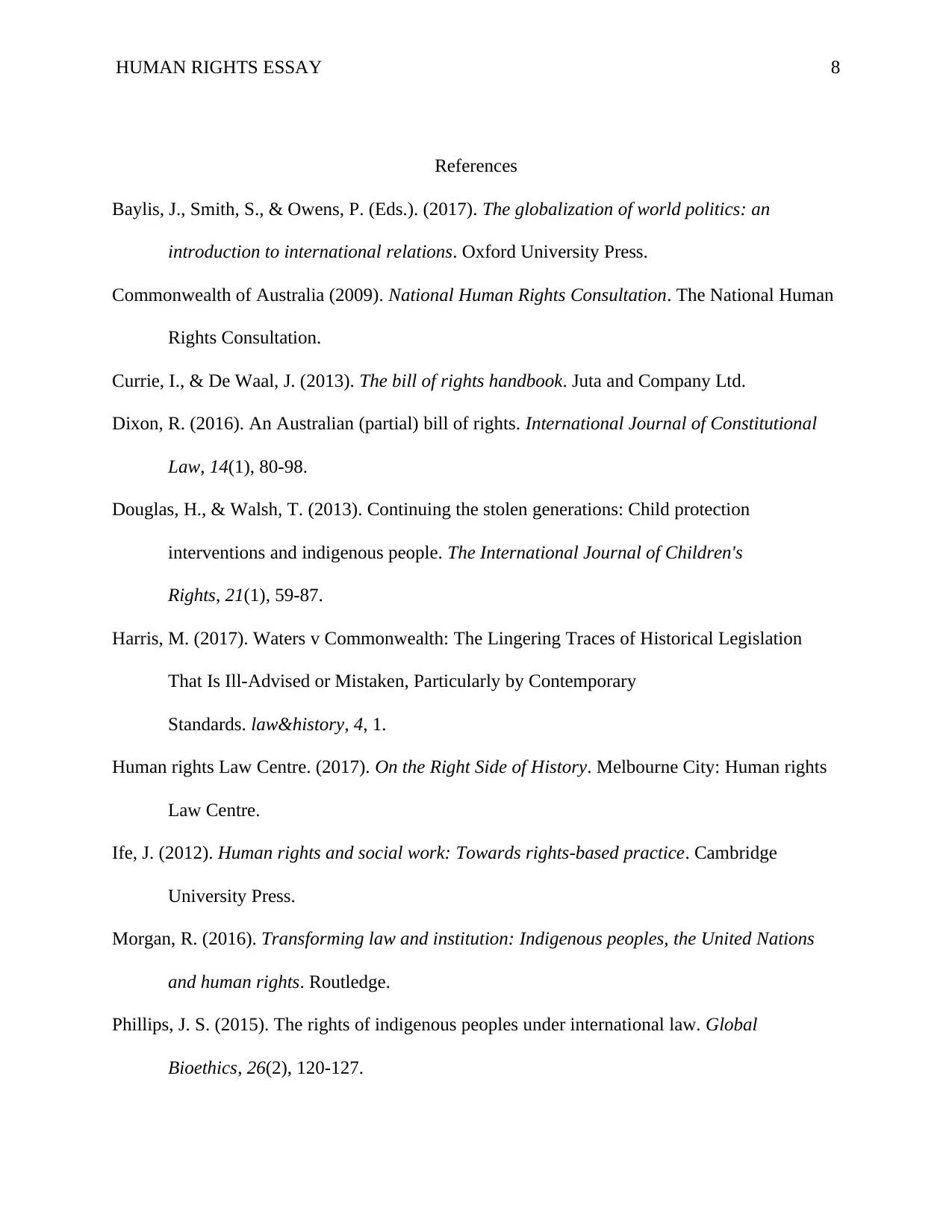
HUMAN RIGHTS ESSAY 8
References
Baylis, J., Smith, S., & Owens, P. (Eds.). (2017). The globalization of world politics: an
introduction to international relations. Oxford University Press.
Commonwealth of Australia (2009). National Human Rights Consultation. The National Human
Rights Consultation.
Currie, I., & De Waal, J. (2013). The bill of rights handbook. Juta and Company Ltd.
Dixon, R. (2016). An Australian (partial) bill of rights. International Journal of Constitutional
Law, 14(1), 80-98.
Douglas, H., & Walsh, T. (2013). Continuing the stolen generations: Child protection
interventions and indigenous people. The International Journal of Children's
Rights, 21(1), 59-87.
Harris, M. (2017). Waters v Commonwealth: The Lingering Traces of Historical Legislation
That Is Ill-Advised or Mistaken, Particularly by Contemporary
Standards. law&history, 4, 1.
Human rights Law Centre. (2017). On the Right Side of History. Melbourne City: Human rights
Law Centre.
Ife, J. (2012). Human rights and social work: Towards rights-based practice. Cambridge
University Press.
Morgan, R. (2016). Transforming law and institution: Indigenous peoples, the United Nations
and human rights. Routledge.
Phillips, J. S. (2015). The rights of indigenous peoples under international law. Global
Bioethics, 26(2), 120-127.
References
Baylis, J., Smith, S., & Owens, P. (Eds.). (2017). The globalization of world politics: an
introduction to international relations. Oxford University Press.
Commonwealth of Australia (2009). National Human Rights Consultation. The National Human
Rights Consultation.
Currie, I., & De Waal, J. (2013). The bill of rights handbook. Juta and Company Ltd.
Dixon, R. (2016). An Australian (partial) bill of rights. International Journal of Constitutional
Law, 14(1), 80-98.
Douglas, H., & Walsh, T. (2013). Continuing the stolen generations: Child protection
interventions and indigenous people. The International Journal of Children's
Rights, 21(1), 59-87.
Harris, M. (2017). Waters v Commonwealth: The Lingering Traces of Historical Legislation
That Is Ill-Advised or Mistaken, Particularly by Contemporary
Standards. law&history, 4, 1.
Human rights Law Centre. (2017). On the Right Side of History. Melbourne City: Human rights
Law Centre.
Ife, J. (2012). Human rights and social work: Towards rights-based practice. Cambridge
University Press.
Morgan, R. (2016). Transforming law and institution: Indigenous peoples, the United Nations
and human rights. Routledge.
Phillips, J. S. (2015). The rights of indigenous peoples under international law. Global
Bioethics, 26(2), 120-127.

HUMAN RIGHTS ESSAY 9
Spencer, Z. and Allison, k. (2018). Human Rights For and Against. [epdf] Victoria: The
Australian Collaboration. Available at:
http://www.australiancollaboration.com.au/pdf/Essays/Human-Rights-For-Against.pdf
[Accessed 6 Aug. 2018].
Spencer, Z. and Allison, k. (2018). Human Rights For and Against. [epdf] Victoria: The
Australian Collaboration. Available at:
http://www.australiancollaboration.com.au/pdf/Essays/Human-Rights-For-Against.pdf
[Accessed 6 Aug. 2018].
⊘ This is a preview!⊘
Do you want full access?
Subscribe today to unlock all pages.

Trusted by 1+ million students worldwide
1 out of 9
Related Documents
Your All-in-One AI-Powered Toolkit for Academic Success.
+13062052269
info@desklib.com
Available 24*7 on WhatsApp / Email
![[object Object]](/_next/static/media/star-bottom.7253800d.svg)
Unlock your academic potential
Copyright © 2020–2025 A2Z Services. All Rights Reserved. Developed and managed by ZUCOL.





